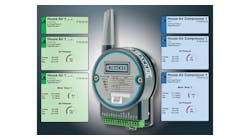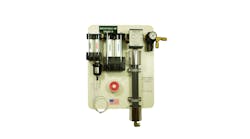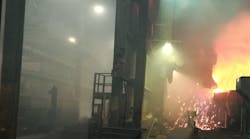Since June the U.S. Occupational Health and Safety Administration (OSHA) has been applying its final rule for minimizing and managing workers’ exposure to respirable crystalline silica, and by now foundries should have a clear grasp of the sampling methodologies and protocols that are required under the new rule. Sampling methods have been addressed in detail in an earlier report, though in our experience many foundry managers and their industrial hygienists have had difficulty complying with the new standard.
However, sampling is only one of the primary requirements under the regulation. In addition to gathering comprehensive employee-exposure data through sampling, the employer also must implement all feasible engineering controls within their facility and create a written exposure control plan.
Prior to these next two steps, the employer must do two things. First, define the phrase “all feasible engineering controls.” And second, determine what information will be included in the written exposure control plan that must be developed.
While our primary purpose is to comply with the OSHA standard in order to create a safe and healthy workplace, many employers have chosen to take a more holistic risk-management approach. In doing so, they have incorporated their engineering solutions and documentation elements intended to mitigate litigation-related risks to the organization into their written exposure control plan.
Regardless of the approach, it is advised to make these decisions early in the compliance process.
First, let’s look at engineering controls. Engineering controls’ feasibility may be determined primarily through technological feasibility and financial feasibility. As most feasible engineering controls are specific to the work site, rather than discussing specific controls, we will look at common mistakes that we have seen in the implementation of those controls.
One of the first misunderstandings we encounter is in the area of financial feasibility. The safety and well-being of employees should never be primarily determined by cost. Just try to explain to a compliance officer that a solution was expensive, so it was not implemented. It’s not an argument any foundry would want to support.
However, every organization will reach a point where the cost of a new process or procedure will not be justified by the reduction in risk. Engineering controls that are extremely expensive but provide very minimal reduction in silica exposure may not be in the best interests of the company, or the employees. Historically, OSHA has recognized that when the implementation of engineering controls requires a significant and harmful financial burden to the employer, personal protective equipment (PPE) or administrative controls may be used. However, to support this conclusion, it is advisable to document the analysis and evaluation as a part of the exposure control plan.
A careful analysis of the facility, the silica sources and available methods of reduction are critical. Comparative analysis is an important tool. What are other, similar facilities doing? What has been successful? What were the costs associated with the controls used in other, similar facilities? What is unique or different about this facility? What similarities can be capitalized on? Failure to ask these questions and document the answers may lead to either needless financial expense, or to missing key engineering solutions that would aid in compliance with the silica regulations.
Employers may find it beneficial to engage silica-compliance experts with experience in their specific industry to assist in this comparative analysis, as most employers will have only their own experiences on which to base their decisions. The assistance of an independent expert provides another benefit, often cited by employers. An independent expert is, by definition, unbiased. In the event of litigation, this could be a critical element in the presentation of the employer’s silica-compliance efforts.
Another common mistake we see when implementing engineering controls is a failure to properly determine the silica sources. Many employers are very effective in determining employee exposure levels and yet fail to identify where the silica is actually coming from, or moving to, within the facility. We have seen dozens of examples of engineering controls being put in place, sometimes with significant cost to the organization, only to result in little or no reduction in silica-exposure levels. Most often, this is due to the employer seeking to solve the wrong problem. They have relied on “common sense”, “tribal knowledge”, “gut feelings”, “intuition” or other similar methods of evaluation that were not based on accurate data.
This leads back to an earlier (June 2017) report regarding the importance of gathering an accurate and comprehensive data set prior to implementing engineering controls.
Let’s take a look at some actual examples of engineering control failures. Most of these resulted in significant expenditures for the employers, both in time and money.
• A foundry assumes the primary source of silica is shakeout, which then is isolated, enclosed and ventilated. Only then is it discovered that there is no significant reduction in exposure levels to their employees.
• A casting cleaning firm installs numerous fans to disperse silica. Rather than the expected reduction in silica levels, the installation results in increased exposure levels for employees.
• A casting producer installs side-draft hoods in the finishing area. These hoods do not solve the exposure problems, resulting in substantial modifications and additional costs.
• A foundry cuts holes in makeup-air ductwork high in the foundry, to reduce air pressure. This air could have been redirected to solve other silica issues but instead is being used to distribute respirable silica that has collected on the catwalks and structure throughout the foundry.
• A foundry installs fans to move air in stagnant areas, but the fans blow over free-falling sand, distributing respirable silica throughout the foundry.
• A foundry installs additional dust-collection equipment, without additional makeup air. Negative pressure in the building reduces effectiveness of the collection system, resulting in additional costs. Further evaluation determines that a smaller dust collector combined with a makeup air unit would have been more effective and less expensive.
• A foundry installs collection but does not effectively enclose or hood it, reducing effectiveness.
• A foundry reallocates collection for new process and is no longer collecting the original process effectively, causing an increase in employee exposure.
• A foundry collects particulate data instead of silica data: We have over 15 examples of employers who collected extensive data regarding respirable particulate, and used that data to make silica-related decisions, resulting either in no reduction or even increases in employee-exposure levels.
Once the data has been collected and analyzed, and the engineering controls implemented, the employer must document the controls used to reduce employee exposure to respirable crystalline silica. The requirements for the silica-exposure control plan are clearly explained by OSHA in the regulation.
However, we recommend that you consider exceeding the minimum requirements and use this plan as a comprehensive silica-compliance document. In addition to the engineering controls, administrative controls, and PPE that are being used to comply with the standard, it is advisable to include the analysis process that determined what is feasible and what is not.
Document which controls were considered, which were chosen, which were rejected, and why these decisions were made. Include a summary of any data-collection processes, audits, evaluations, comparative analysis and sampling that were completed. Include the costs (in both time and money) associated with the compliance efforts taken to date.
Document the improvements achieved. Attach the baseline and most recent employee sampling data, complete with the relevant information covered in the previous report. Compile all of this into one document so that in the event of an OSHA compliance investigation, all relevant information is readily accessible and comprehensible. This document should be accessible to employees and their representatives, and should be reviewed and updated at least annually.
Compliance with the new OSHA Silica standard does not have to be terrifying, but it should be sobering. This is a detailed and complicated standard that has, at its core, a mandate to reduce the levels of silica that employees are exposed to, using all feasible engineering controls before even considering PPE. It is not something to be taken lightly, but it is achievable.
In many ways, success in complying with this standard can be summed up with the old maxim, “Garbage in. Garbage out.” Quality data and knowledgeable analysis of the data will, in most cases, result in a successful silica-compliance program and a reduction in the risks that our employees are exposed to daily.
Trent Blake is the director of Security, Health and Safety Services for Keramida Inc., which engineers and develops global EHS and sustainability programs. Contact him at [email protected]









